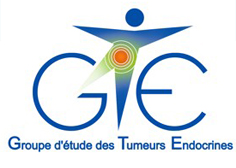COMPETE
- Type d'étude :
- Phase III
- Promoteur :
- ITM-solu
- Etat actuel de l'étude :
- Terminée aux inclusions
Prospective, randomised, Controlled, Open-label, Multicentre phase III study to evaluate efficacy and safety of Peptide Receptor Radionuclide Therapy (PRRT) with 177Lu-Edotreotide compared to targeted molecular therapy with Everolimus in patients with inoperable, progressive, somatostatin receptor-positive (SSTR+), gastroenteropancreatic neuroendocrine tumors (GEP-NET).
COMPETE
GEP-NET
Interventionnelle : 177Lu-Edotreotide (4 cycles, espacés de 3 mois) vs. Everolimus in P-NET
Phase III randomisée 2:1
Pr. Ruszniewski (Clichy)
Lyon, Clichy, Montpellier, Nantes
Objectif principal : To demonstrate the efficacy of PRRT with 177Lu-edotreotide to prolong median progression-free survival (mPFS) in patients with inoperable, progressive, SSTR+ P-NET, compared to Everolimus.
Objectifs secondaires :
1. To assess overall survival (OS) during study period, defined as the date from randomisation until death
2. To determine objective response rates (ORR), defined as the proportion of patients achieving partial (PR) or complete response (CR) as best outcome
3. To determine disease control rates (DCR), defined as the proportion of patients achieving stable disease (SD), PR or CR as best outcome
4. To determine the duration of disease control (DDC), measured from the time of initial diagnosis of response (SD, PR or CR), until diagnosis of progression
5. To determine functional response rates (FRR), considering Cg-A and specific hormones (where increased at baseline)
6. To assess the safety and tolerability of 177Lu-edotreotide in P-NET patients
7. To determine the health-related quality of life (HRQL) in P-NET patients during and after therapy (EORTC QLQ-C30 questionnaire)
8. To evaluate symptomatic tumour response (EORTC GI.NET21 questionnaire)
9. To evaluate the impact of patient characteristics (time from primary diagnosis, time from diagnosis of progression, number of prior therapies (1st vs 2nd line), type of prior therapies, KPI at randomisation) on tumour response
10. To evaluate the impact of tumour histology (histological entity, tumour grade, Ki-67 expression, SSTR expression, functional state), as determined in primary or current tumour specimen, on tumour response
1. Written informed consent
2. Male or female ?18 years of age
3. Histologically confirmed diagnosis of well-differentiated neuroendocrine tumour of GEP-NET, grade G1 or G2 (Ki-67 < 20%), unresectable or metastatic
4. Availability of existing biopsy specimen from primary tumour or metastasis or, if unavailable, willingness to undergo current biopsy for secondary central analysis
5. Measurable disease per RECIST 1.1, on CT/MRI scans, defined as at least 1 lesion with ?1 cm in longest diameter, and ? 2 radiological tumour lesions in total
6. Somatostatin receptor positive (SSTR+) disease, as evidenced by SSTR imaging (SRI) within 3 months prior to randomisation, by:
• 68Ga-based SSTR PET imaging (e.g. using 68Ga-edotreotide or 68Ga-DOTATATE), or
• 111In-pentetreotide SSTR SPECT/planar imaging, or
• 99mTc-octreotide SSTR SPECT/planar imaging, demonstrating adequate tracer uptake, clearly differentiable from background
7. Radiological disease progression, defined as:
• Progressive disease per RECIST 1.1. criteria, evidenced by consecutive morphological imaging (CT or MRI) with ? 90 days interval during the 12 months prior to randomisation
8. Karnofsky performance status (KPS) scale ? 80
9. Life expectancy of at least 6 months
10. Glomerular filtration rate (GFR, MDRD) ? 60 mL/min/1.73 m2
1. Known hypersensitivity to edotreotide or Everolimus
2. Known hypersensitivity to DOTA, lutetium-177, or any excipient of edotreotide or Everolimus
3. Prior exposure to any peptide receptor radiotherapy (PRRT), including 177Lu-edotreotide, 90Y-edotreotide or other SSTR-targeting agents (e.g. 177Lu-octreotate or high-dose 111In-pentetreotide)
4. Prior therapy with Everolimus
5. Prior EFR (extended field radiation) to lesions or radioembolisation therapy (e.g. 90Y microspheres, 131I-lipiodol) with administration to the liver
6. Prior therapy with an investigational compound and/or medical device within 3 months prior to screening
7. Current therapy with any prohibited medication
8. Ongoing toxicity grade 2 from previous standard or investigational therapies (Common Terminology Criteria for Adverse Events (CTCAE) version 4.03)
9. Indication for surgical lesion removal with curative potential
10. Planned (for the period of study participation): chemotherapy, immunotherapy, radiation therapy, chemo-embolisation, bland embolisation, radio-embolisation, treatment with cyclosporine-A
11. Neuroendocrine tumours, not meeting the inclusion criteria:
• With known extra-pancreatic (e.g. pulmonary, gastro-enteral or gonadal) primaries
• NET with unknown primaries (CUP), manifesting as liver metastases Poorly differentiated neuroendocrine carcinomas (grade G3)
• NET for which no histological specimen for secondary histological analysis can be obtained
12. Brain metastases
13. Secondary malignoma within previous 5 years
14. Serious non-malignant disease (e.g. psychiatric, infectious, autoimmune or metabolic), that may interfere with the objectives of the study or with the safety or compliance of the subject, as judged by the investigator
15. Renal, hepatic, cardiovascular, or hematological organ dysfunction, potentially interfering with the safety of the study treatments, as follows:
• Renal
– Serum creatinine ? 1.5 x ULN, or creatinine clearance (GFR, MDRD) < 60 mL/min/1.73 m2
– Renal obstruction
– Known nephropathy from any cause
• Hepatic
– Total bilirubin > 2.5 x ULN
– AST or ALT > 2.5 x ULN
– alkaline phosphatase > 5 x ULN
– Known cirrhosis
• Cardiovascular
– New York Heart Association classification IV
– Uncontrolled hypertension
• Haematopoietic
– Platelets < 80 * 109/mL
– Absolute neutrophil count (ANC) < 1,000/mL
16. Pregnant or breast-feeding
17. Subjects not able to declare meaningful informed consent on their own (e.g. with legal guardian for mental
